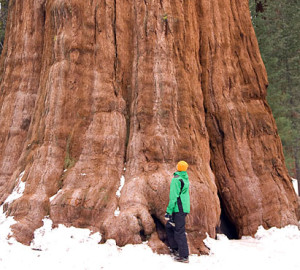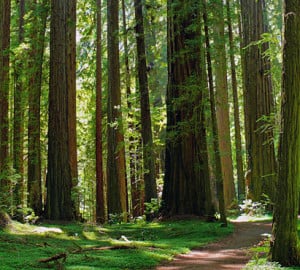FAQs
See answers to frequently asked questions about Save the Redwoods League and redwoods.
See answers to frequently asked questions about Save the Redwoods League and redwoods.

Redwood species grew throughout North America, Europe and Asia 144 million years ago. Over time and in response to an ever-changing environment, they retreated from most of their former range, and many once-abundant redwood species became extinct.

Please make checks payable to “Save the Redwoods League.” We accept all major credits cards. There is also the option of making monthly payments from your checking account or credit card.

Unlike the coast redwoods, loggers found less value in the giant sequoias. When felled, the colossally heavy and brittle sequoia trees often shattered when they hit the ground. Still, about 35 percent of the original sequoia forest was logged. Currently, 96 percent (46,000 acres) of the historical giant sequoia range is protected, and 4 percent (2,000 acres) is privately owned.
Today, Save the Redwoods League works to protect and restore redwood forests and their surrounding lands and waterways. The League has protected more than 200,000 acres throughout the redwood range.
“Saving” the redwoods means much more than just protecting old-growth, important as that is. With careful management, previously logged or disturbed lands can be restored to health; and modern-day threats like development and climate change make the work of redwoods protection more complex than ever. Leading-edge science and the support of its dedicated members and partners make it possible for the League to continue the important work of redwood forest conservation.
Old-growth forests are characterized by diverse, and often rare, communities of plants and animals due to the long period of forest stability. The imperiled Humboldt Marten, for example, relies on old-growth forest attributes to survive. It needs large fallen logs for shelter, and bountiful shrubs for foraging habitat. Through science-based restoration, younger forests can attain old-growth characteristics, like large trees, over time, healing the damage of the past and allowing wildlife communities to return and thrive once again. The League places a high priority on projects that will help to bring about the ancient redwood forests of tomorrow. Visit our restoration webpages to learn more about this exciting work.
However, the “family tree” of these famous giants is far more extended than just the two species. In fact, the relatives of coast redwoods and giant sequoias are found on every continent except Antarctica! The “redwood relatives” thrive in all sorts of environments, from the arctic in Norway to the southernmost areas of Chile, and from 17,000 feet (5,200 m) in the mountains of Tibet all the way down to sea level. While they can grow in a variety of temperate zones, each species has adapted to survive in very specific environmental conditions. Coast redwoods hug the California coast using fog as a water source, while the golden Vietnamese cypress grows on jagged ridges and summits in the cloud forests of Vietnam, and the bald cypress dominates swampy lowlands in the southeastern United States.
The earliest specimens of these trees first appeared on the planet more than 200 million years ago, during the Mesozoic Era. Though the ice ages of the past 2 million years greatly affected the distribution of these tree species, redwood relatives still occupy many habitats around the world. Many of the remaining living examples today are considered relic species, including the coast redwood, giant sequoia, dawn redwood and alerce. They are the sole surviving representatives of ancient groups of plants that used to be far more widely distributed across the globe.
Visit the Redwood Relatives page for more information about the cypress family, including an interactive map of the species’ global distribution.

Unfortunately, today the work needed to protect redwood forests is harder and more complex than ever before. Many redwood lands are still struggling to recover from years of past damage and neglect. To thrive, protected forests also depend on the health of nearby land, much of which is privately owned, including property of commercial timber companies. People also use land in ways incompatible with forest health, through development or conversion to vineyards, for example; and we must find a balance between meeting human needs and the needs of the forest. In addition, we do not yet know the impact that the Earth’s changing climate will have on the size, strength and survival of redwood trees and forests.
Sustainable forestry is the practice of managing dynamic forest ecosystems to provide ecological, economic, social and cultural benefits for present and future generations (Wisconsin Department of Natural Resources 2006). A sustainable forest is also known as a working forest: some trees are removed, but with the health of the forest and its inhabitants in mind. This method supports local economies, protects tree species, and improves the health of the forest.
Protected forests can gain health benefits from a sustainable forestry practice. In fact, removing select trees in protected forests is often necessary to prevent the spread of high-intensity forest fires and to restore forests that are too dense with young trees. If young trees are growing together too closely, none of the trees have enough light, space, water or nutrients to grow. By removing some of the young trees, we lessen the competition and help the remaining trees mature more quickly.
If you want to be assured of sustainable forestry practices, choose paper and wood products that are certified by a third-party organization like the Forest Stewardship Council (external link). Keep in mind that these third-party organizations have varying standards, some more stringent than others, and that the definition of “sustainable” can be variable as well. To some views, a sustainable forest is simply one that will keep producing a supply of wood that can be harvested. Others, like the League, consider sustainable to mean that all of the ecological systems of a forest — like its waterways, plants and animals, and soils — remain healthy and intact. California has strict rules governing forestry; many believe these standards promote sustainable forestry in their own right.
The League does not support clearcutting (a practice in which virtually all of the trees in a given area are uniformly cut down) in the redwood forest. While clearcutting may be appropriate in certain forest types — in some parts of the Boreal, or in some of the catastrophic fire-driven pine forests in the southeastern U.S. — it is not reflective of the natural processes of either the coast redwood or giant sequoia forest.
The League does not take a position on timber harvest plans on private land, but we appreciate having this information in case it relates to a landowner we are working with or a project we are working on in the area.

We receive inquires year-round on properties ranging from huge swaths of forest, to small private parcels, to land with few or no redwoods at all. Many of the properties that we evaluate do not meet the criteria for us to buy or steward the property. Some properties fall outside of our science-based Vibrant Forest Plan while other projects simply may not have enough ecological, scenic or historic significance. Still, we acknowledge that every parcel in California is important to all of us, and we wish we could protect them all. Since we have limited resources, we carefully follow our guidelines to advance our mission to protect these magical places and connect people to the wonder of the redwoods.
Land owners are not obligated to work with us and owners may have legal rights to clear the trees and develop or convert the land to other use. This is why the League’s work to protect important properties when we have the chance is so critical.



Whether you live within or outside of California, we recommend planting trees that are native to your area. Native plants are always preferable because they are adapted to an area’s climatic and soil conditions. Within California, we also recommend choosing a tree that will fit your yard’s space limitations as it matures.
For more information, visit SaveTheRedwoods.org/redwoods or your local nursery. You may contact the Tree Care Industry Association (external link) to find an accredited tree care company in your area or call (800) 733-2622.
Coast redwoods thrive in California’s coastal climate because of moderate year-round temperatures, abundant winter rains and summer fog that supplies the moisture they need to survive the summer droughts typical of this area. In addition to their dependence on moisture, coast redwoods also are susceptible to frost damage if subjected to extended periods below freezing.
Giant sequoias thrive in California’s Sierra Nevada because they receive water from the heavy snowpack that accumulates each winter. Melting snowpack in the spring and summer delivers the moisture that sequoias need to survive the summer droughts typical of this area.
Prolonged periods of hot weather above 100 degrees can be lethal to coast redwoods and giant sequoias as the trees become stressed from lack of moisture.

About Coast Redwoods
About Giant Sequoias
History of Logging in the Redwoods
Children’s Books
See more on our book list for children.

The League maintains that redwoods stand at a new crossroads of environmental change where urbanization, habitat fragmentation, invasive species and climatic changes in combination threaten these forests in ways they have not yet experienced in their long history on Earth. We are currently evaluating any potential benefits of carbon offset programs for redwood forests.

As the nature of land conservation work and of California State Parks’ work changes, the League’s role as a parks partner adapts and grows as well. Historically, the League has acquired properties and bequeathed them to State Parks for management, leading to the creation of many of our beloved redwoods state parks. Now, the League is expanding its role as a property steward in its own right, and continues to assist CSP with parks improvement projects. Learn more about our proud partnership and how you can help California’s state parks.
Have more questions? Contact us at (415) 362-2352 or membership@SaveTheRedwoods.org. Please see our Privacy Policy for a description of the information the League collects on its website.